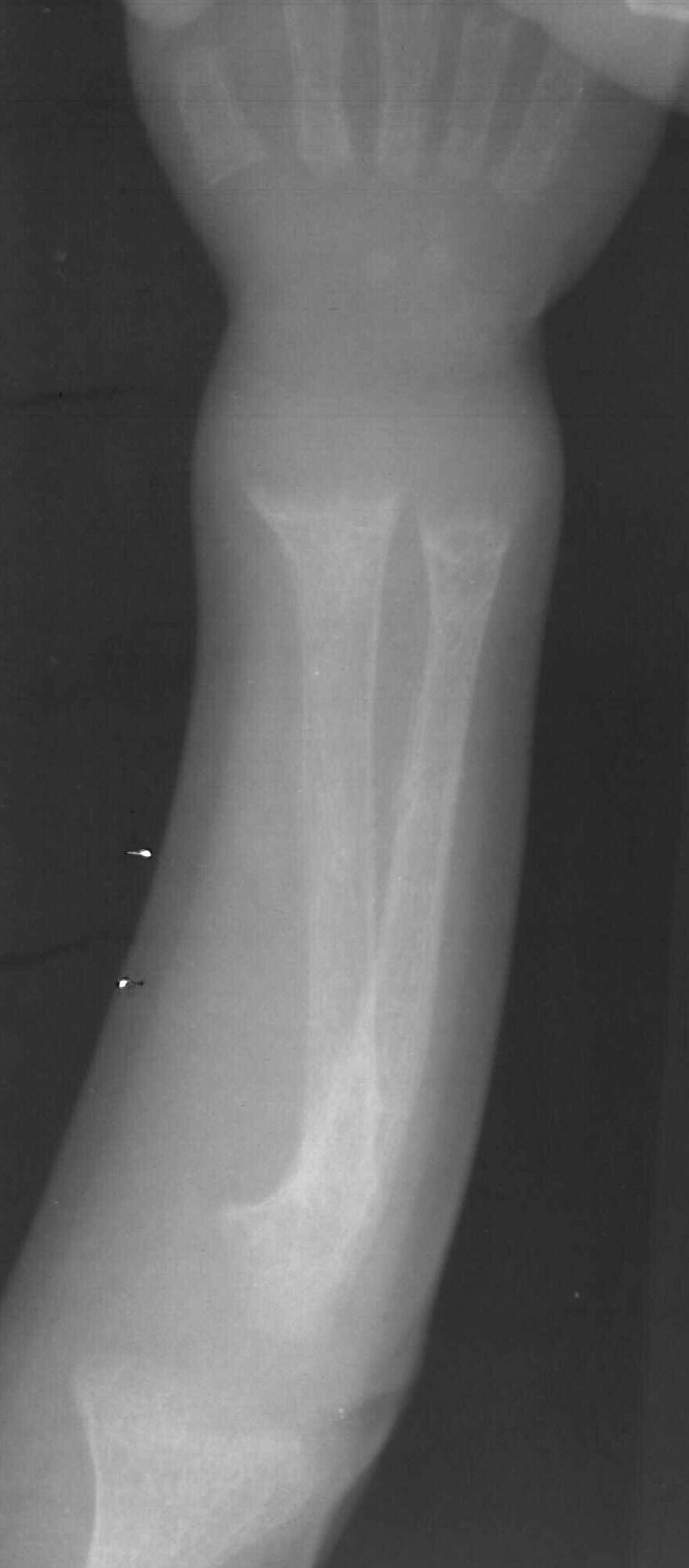Rickets
Rickets is a disease caused by deficiency of Vitamin D leading to bony deformities and hypocalcaemia.
Rickets is a disease caused by deficiency of Vitamin D leading to bony deformities and hypocalcaemia.
Pathophysiological basis of radiographic findings in Rickets
Loss of orderly maturation and mineralization of cartilage cells at the growth plate resulting from Vitamin D deficiency is ‘Rickets’. Thus, Rickets is like osteomalacia in a growing skeleton.
Inherent to all rachitic syndromes are osteomalacic changes in portions of skeleton that contains mineralized bone (Mature bone-both compact & spongy).
The skeletal effects are due to lack of calcification of osteoid. The most obvious change are at ‘metaphysis’- where rapid growth is occurring.
First change to appear is a ‘loss of normal zone of provisional calcification’ adjacent to metaphysis. This begins as an indistinctness of the metaphyseal margin, progressing to a ‘frayed’ appearance with widening of the growth plate, due to lack of calcification of metaphyseal bone. Weight bearing & stress on uncalcified bone gives rise to ‘splaying’ & ‘cupping’ of metaphysis. A similar but less marked effect occurs in subperiosteal layer , which may cause lack of distinctness of cortical margin. Eventually a generalized reduction in bone density is seen. In the epiphysis – there may be some haziness of cortical margin. Thus all findings in Rickets occur due to failure of calcification & abnormal demineralization
Healing Rickets
The first changes of rickets appear in rapidly growing distal ends of ulna & radius (wrist & knee are commonly involved due to more use). Rarefaction of provisional zone of calcification with widening of epiphysis- diaphysis distance is first to appear. Following treatment there is ossification of provisional zone of calcification.
Healing Rickets
The first changes of rickets appear in rapidly growing distal ends of ulna & radius (wrist & knee are commonly involved due to more use). Rarefaction of provisional zone of calcification with widening of epiphysis- diaphysis distance is first to appear. Following treatment there is ossification of provisional zone of calcification.
However, early signs of Rickets should be always looked for e.g. On chest X-ray, humoral head may show certain early radiological changes
Skull & spine changes in Rickets
Skull changes | -Pronounced calvarial demineralization
(Even facial bones are involved)
| -Basilar Invagination
| -Indistinct sutural margin
| -Delayed tooth eruption
| -Premature craniostenosis
| -Craniotabes
| -Calvarial thickening following treatment
Spine changes | -Scoliosis
| -Biconcave vertebral bodies
| -Triradiatic pelvis.
(Even facial bones are involved)
| -Basilar Invagination
| -Indistinct sutural margin
| -Delayed tooth eruption
| -Premature craniostenosis
| -Craniotabes
| -Calvarial thickening following treatment
Spine changes | -Scoliosis
| -Biconcave vertebral bodies
| -Triradiatic pelvis.
Imaging signs of healing Rickets
With treatment, there is regression of radiological findings seen in Rickets. During a stage of healing, there is extensive periosteal new bone formation as a reflection of ossification occurring along the cornices of diaphyses. Also seen during healing are radiolucent bands at metaphyses of long bones & cupping of metaphyses becomes clearly prominent. As healing progresses remodeling of bowing deformities occur & in skull characteristic bossing of frontal & parietal bones becomes apparent with premature closure of sutures.
With Renal Tubular acidosis, a peculiar brush border along the metaphysis is seen in the healing phase.
Vitamin D Resistant Rickets on imaging
Vitamin D Resistant Rickets is found in older children (>30months of age). Patient is short, stocky & bow legged. Ectopic calcifications & ossification in axial/appendicular skeleton along with occasional sclerotic changes are among the identifying radiographic features. Bowing of legs & shortening of long bones are more pronounced. Bones are more sclerotic.
With Renal Tubular acidosis, a peculiar brush border along the metaphysis is seen in the healing phase.
Vitamin D Resistant Rickets on imaging
Vitamin D Resistant Rickets is found in older children (>30months of age). Patient is short, stocky & bow legged. Ectopic calcifications & ossification in axial/appendicular skeleton along with occasional sclerotic changes are among the identifying radiographic features. Bowing of legs & shortening of long bones are more pronounced. Bones are more sclerotic.
Neonatal Rickets
In first 2 years of life, incidence of Rickets is 5 to 20%. Neonatal rickets is believed to be of multifactorial origin. Major contributing factors are related to nutrition, immaturity of enzyme systems & iatrogenic / metabolic factors. Premature infants of low birth weight are primarily affected. Bony changes appear around 2 months of age. The most frequent causes of Rickets in patients under 6 months of age also include conditions like Biliary Atresia.
In first 2 years of life, incidence of Rickets is 5 to 20%. Neonatal rickets is believed to be of multifactorial origin. Major contributing factors are related to nutrition, immaturity of enzyme systems & iatrogenic / metabolic factors. Premature infants of low birth weight are primarily affected. Bony changes appear around 2 months of age. The most frequent causes of Rickets in patients under 6 months of age also include conditions like Biliary Atresia.
Sequelae post-rickets
Complete healing & restoration of normal structure are rule in rickets, however distortion/ sclerosis of spongiosa in affected segment may occur after healing & may remain visible for several years. Cortical thickening of segments of bone involved during active stage also may persist. Angulation deformities secondary to pathological fractures result in deformities like knock-knee, bow leg and saber shin.



